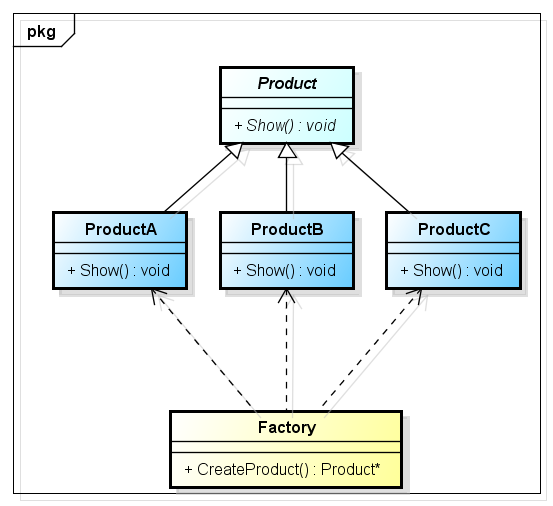

ProductA、ProductB和ProductC继承自Product虚拟类,Show方法是不同产品的自描述;Factory依赖于ProductA、ProductB和ProductC,Factory根据不同的条件创建不同的Product对象。
之前在公司做了一个windows 8平台的阅读器。首先,需要将电子书中的内容渲染到屏幕上,而电子书每一页都包含各种各样的内容,比如:图形、图像和文字等等;不同的内容,就是不同的对象;在将不同的内容渲染到屏幕上之前,就需要new操作,建立不同的对象,然后再在屏幕上进行描绘。这个时候,就需要进行很多new操作,new操作分布在代码的不同地方,管理起来很麻烦,而且也很乱,到后期扩展和维护的时候,有的时候,对象多的让开发人员不知道这个对象是干什么的,这就增加了难度;同时,new操作,都会有对应的异常处理,最后,就会发现,在代码中,new了一个对象,然后,就跟着一段异常处理代码,这时编码变的极其混乱和臃肿。那么怎么办?怎么办?此时,我们需要一个新的类,专门从事对象的建立和释放,之后,对象的各种操作,和这个类没有任何关系。这个专门建立对象的类,向外暴漏创建对象的接口,供外部调用。
工厂模式有一种非常形象的描述,建立对象的类就如一个工厂,而需要被建立的对象就是一个个产品;在工厂中加工产品,使用产品的人,不用在乎产品是如何生产出来的。从软件开发的角度来说,这样就有效的降低了模块之间的耦合。
UML类图对于工厂模式,具体上可以分为三类:
对于上面的三种工厂模式,从上到下逐步抽象,并且更具一般性。而这篇博文主要讲的是简单工厂模式,后两种会在之后的博文中接着总结。

ProductA、ProductB和ProductC继承自Product虚拟类,Show方法是不同产品的自描述;Factory依赖于ProductA、ProductB和ProductC,Factory根据不同的条件创建不同的Product对象。
| 欢迎光临 firemail (http://firemail.wang:8088/) | Powered by Discuz! X3 |